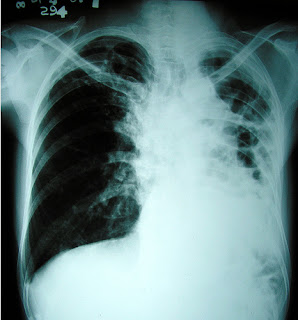Pulmonary Tuberculosis (TB) is a contagious bacterial infection that involves the lungs, but may spread to other organs.
The primary stage of TB Usually does not cause symptoms. When symptoms of pulmonary TB occur, they may include:
- Cough (usually cough up mucus)
- Coughing up blood
- Excessive sweating, especially at night
- Fatigue
- Fever
- Unintentional weight loss
Other symptoms that may occur with this disease:
- Breathing difficulty
- Chest pain
- Wheezing
Nursing Diagnosis for Pulmonary Tuberculosis: Ineffective Airway Clearance
related to: the viscous secretions / blood.
Goal: Cleanliness effective airway.
Expected outcomes:
- Clients no additional breathing.
- Clients find a comfortable position that allows increased air exchange when indicated.
- Clients drink lots (1500 - 2000 cc) to reduce the viscosity of secretions.
Nursing Interventions: Ineffective Airway Clearance relate to Pulmonary Tuberculosis
1. Teach the client about the proper method of controlling cough.
Rationale: Coughing hard causes bleeding in the pulmonary veins.
2. Perform diaphragmatic breathing.
Rationale: Respiratory diaphragm lower respiratory rate and increased alveolar ventilation.
3. Auscultation of the lungs before and after coughing.
Rationale: This helps evaluate the effectiveness of cough effort.
4. Teach client action to reduce the viscosity of secretions: maintain adequate hydration; increase fluid intake 1000 to 1500 cc / day if not contraindicated.
Rational: Secretion difficult to dilute thick and can cause blockage of mucus, which leads to atelectasis.
5. Encourage or provide good oral care after coughing.
Rationale: good oral Hiegene increase sense of well being and prevent bad breath.
6. Explain to the client and the family to comply with the advice of the doctors and nurses: as avoiding foods that cause coughing, as well as odors.
Rationale: With clear information clients are expected to work together in providing therapy.
7. Collaboration with other health team:
By physicians, radiology and physiotherapy.
Giving drugs
Tredelenbeg position (head down)
Rationale: Evaluating client improvement of bleeding clients of cough blood.
